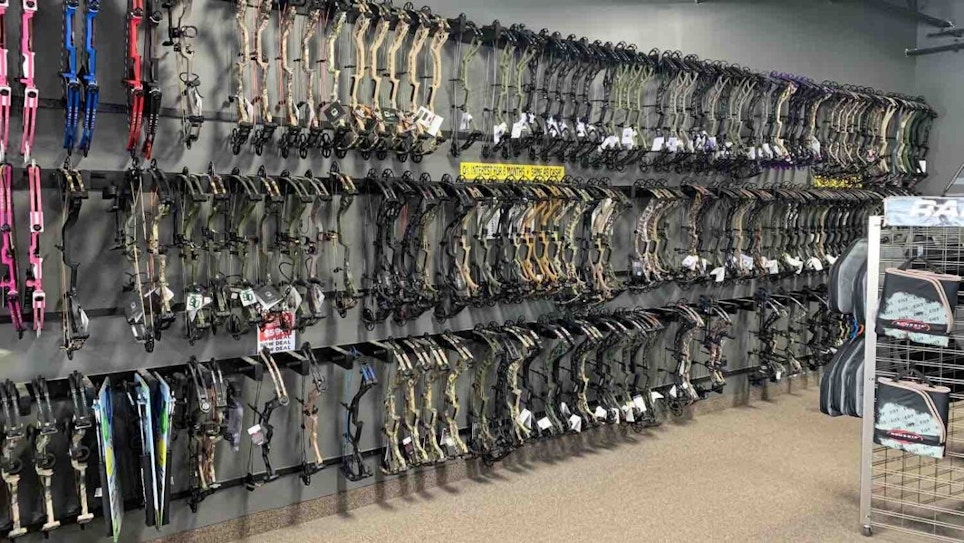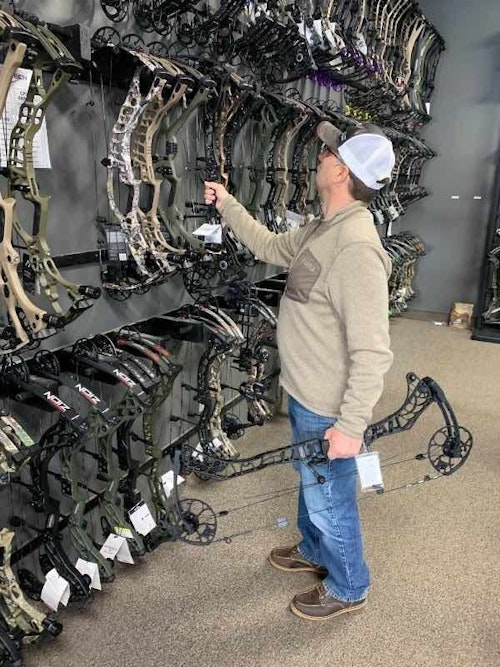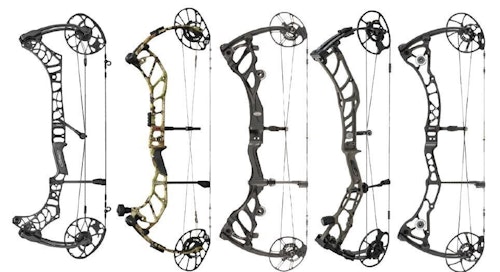
A wide selection of compounds available at Archery Country in Rogers, Minnesota. (Photo by Dave Maas)
Archery dealers have long held great relationships with bow manufacturers. The bonds between bow brands and pro shops is a strong one that has helped bridge the gap between company and consumer. This link has helped drive archery to unprecedented levels of popularity. That said, the market always works itself out, which is true for all areas of the economy. Over time, this has impacted the number of bow brands that pro shops offer their customers, and which ones they carry.
Of course, most archery manufacturers have rules that don’t allow a competing dealer within a certain number of miles. Oftentimes, this ranges from 20-40 miles. While this can impact the data survey, it doesn’t likely change the full-scope totals.
One can take the 150 survey participants (three from each state), extrapolate the data, and see a strong correlation between the data set as if every pro shop in America had been interviewed. With that, let’s dive into the numbers.
Nationwide Averages
During my survey, 150 archery pro shops were selected at random and interviewed. Each was asked to list all compound bow brands they offer their customers. Of those 150 pro shops, 20 different bow brands were stocked by at least one pro shop. These included Mathews, Hoyt, Bowtech, Elite, PSE, Bear, Mission, Prime, Diamond, Darton, Athens, Xpedition, Obsession, Quest, Gearhead, Genesis, APA. Martin, Oneida and .30-06.
When analyzing the number of offerings per store, the nationwide average was close to what I expected. Factoring in all 50 states, the average number of compound bow brands carried by modern pro shops is 4.69 lines. Of course, this number varies greatly by state.
On the low end, these states offered (on average) three or fewer bow brands. These included Rhode Island (2), Mississippi (2), Louisiana (2.33), Indiana (2.67), South Carolina (3) and Vermont (3). On the high end, these states offered six to eight bow brands: Colorado (6), Kentucky (6), Texas (6), Utah (6), Minnesota (6.33), Wyoming (6), Virginia (6.33), Pennsylvania (6.67), Arizona (7), Idaho (7), Montana (8) and Alaska (8).
As I expected, certain bow manufacturers dominated the market share within my survey sample. Each of the top five most-stocked bow manufacturers were carried by at least 51% of pro shops. The next five most-stocked bow companies (Nos. 6-10) were each carried by 12%-42% of pro shops. Analyzing the most-stocked bows within the survey, Mathews took the top spot by being stocked by 74% of survey participants. Hoyt was stocked by 65%, and Bowtech was stocked by 63%; I’d call that tied for second place. Elite was stocked by 52%; PSE, 51%; and Bear, 42%.
While most might guess which bow companies account for the largest chunks of market share without data, the survey information goes to show just how tight the competition is between several manufacturers. Only 2% separated Hoyt and Bowtech, and only 1% separated Elite and PSE.
Regional Variations
While the nationwide data is interesting in and of itself, the regional data is equally intriguing, especially when pouring over focused datasets in the Northeast, Southeast, Midwest and West. The survey responses show just how regional brand loyalty and hunting culture can be.
In the Northeast, the average number of bow brands offered by pro shops was 4.09, which was 0.6 below the national average. This was as I expected, as urban areas are closer together, and with manufacturer minimum mileage distances (between archery dealers), it’s more difficult for pro shops to increase the number of brand offerings. According to survey information, the five most-stocked bows in the region were Bowtech, Mathews, Hoyt, Bear and Elite (in that order).
In the Southeast, the average number of bow brands offered by pro shops was 4.29, which was 0.4 below the national average. Again, this makes sense, as the region is more populated, cities are closer together, and manufacturer minimum mileage distances (between archery dealers) keep pro shops from offering certain bow brands they would otherwise stock. Interestingly, according to the survey, the five most-stocked bows in the region were Mathews, Hoyt, Elite, Bear and Bowtech (in that order).
In the Midwest, the average number of bow brands offered by pro shops was 4.61, which was 0.08 below the national average. This comes as a slight surprise, as I expected the Midwest average to be at or slightly above the national average due to more rural areas. Regardless, the five most stocked bows in the survey responses were Mathews, Hoyt, Bowtech and PSE (tied), and Elite.
Finally, in the West, the average number of bow brands offered by pro shops was 5.78, which was 1.09 above the national average. This was as I expected, as the West is very rural, and archery shops can more easily increase the number of bow brands in-house without violating the minimal mileage distances between dealers. As such, the most stocked brands in the region were Bowtech, Hoyt, Mathews, PSE and Elite (in that order).
Key Takeaways
All things considered, there were three primary takeaways that stood out from my 2023 bow brand survey. First, consumers can expect to shoot four to five different brands when they visit a pro shop. If you as a dealer want to outpace these numbers, it might give you a leg up over neighboring competition.
Second, bow brand loyalty is very regional. This was even truer for some of the smaller bow manufacturers. They were stronger, or weaker, based on the state or region. This signifies a potentially concentrated marketing effort, rather than a large-scale effort.
Third, in the past few years, things seemingly haven’t changed much in regard to market share. That said, as someone who has shot most of the bow brands mentioned here, I can attest that each one makes great bows, regardless of the size of their piece of pie. Virtually all modern compound (and crossbow) offerings are truly innovative. These bows are accurate, durable, effective and reliable. Regardless of the bow brand dealers stock, or that consumers purchase, rest assured it will deliver the goods.
Sidebar: Crossbow Counts
During my survey, I also analyzed crossbow counts, how many lines dealers stocked, and which brands were most stocked. Based on responses to my survey, pro shops carry an average of 2.98 crossbow brands in their establishments. Interestingly, Florida (6.33), Pennsylvania (6), Delaware (5.67), and New York (5) offered the most crossbow brands per pro shop. In contrast, Connecticut (1.67), Ohio (1.67), Hawaii (1.67), Wyoming (1.67), Arizona (1.67), Washington (1.67), Utah (1.33), Alaska (1), South Carolina (1) and Oregon (less than one) offered the fewest. FYI: A person would be hard-pressed to find a crossbow for sale in Oregon, and about the only option you’ll find in Alaska is Mission.
Of the 150 pro shops contacted (three from each state), 18 crossbow companies were stocked by at least one pro shop, including TenPoint, Ravin, Mission, Wicked Ridge, Excalibur, PSE, Barnett, Killer Instinct, Bear, CenterPoint, Axe, Carbon Express, Rocky Mountain, Darton, Xpedition, Scorpyd, Dagger and Browning. Of these 18 companies, eight were stocked by less than 2% of the pro shops. The other 10 companies dominated the market share and were each stocked by 14%-50% of surveyed pro shops. As expected, TenPoint, Ravin, Mission, Wicked Ridge and Excalibur took the top five spots, respectively. TenPoint was stocked by 50% of surveyed pro shops; Ravin, 48%; Mission, 44%; Wicked Ridge, 32%; and Excalibur, 25%.
Sidebar: Key Quotes From Archery Dealers
During my survey, I asked: “Do you carry more, or fewer, compound and crossbow lines as compared to 5 to 10 years ago?” Here’s a sampling of the replies.
- “Mathews and Hoyt are the mainstays, and then Bear for the price point bows. We carry less than we used to.”— On Target Archery and Outdoors, Mays Lick, Kentucky
- “We cut out a few. Shoot seven different brands and consumers get confused. We slimmed down in what we are carrying. It just got to where there was so much to choose from that they got lost in it and walked out the door. We kept what we sell the most of, and that works well.”— Bowhunters Pro Shop, Maryville, Tennessee
- “We carry more. It gives the customers more options. How much the brands advertise determines how many customers come in the door.” — Center Shot Archery, Sarasota, Florida
- “It’s been a roller coaster. We cover more now to cover the different price points.” — Southern Style Archery, Rome, Georgia
- “Fewer. The companies out there try to force you to have so many bows in stock to be a dealer. When you spread yourself between seven or eight brands, you can’t keep a great selection of any one brand because you’re having to spend money on other brands that may not sell as well. A lot of stagnant money hangs on the shelf.” — Archery Unlimited, Prattville, Alabama
- “Being able to have diversity, and fit each niche, is why we branch out.” — Bowhunter Pro Shop, Saraland, Alabama
- “More. The more options you have, the more money you can make. You’re more likely to have what people are looking for.” — Archer’s Advantage, North Little Rock, Arkansas
- “More. Everyone makes an awesome bow, and we like to give customers options.” — Hit or Miss Archery Center, Albuquerque, New Mexico
Sidebar: Bowhunter Strong
Thanks to the Archery Trade Association (ATA), we now have detailed data on the number of bowhunters in each state. The organization worked with state wildlife agencies, and other partners, to determine bowhunter participation numbers. According to the ATA, there are more than 3.76 million bowhunters in America today.
This is beneficial data for pro shops. Break it down to the state level, and it’s even more valuable information. Analyzing that data can impact a myriad of business decisions. The approximated data was as follows:
- Alabama: 97,600
- Alaska: 11,200
- Arizona: 26,600
- Arkansas: 128,800
- California: 8,600
- Colorado: 12,000
- Connecticut: 16,100
- Delaware: 10,500
- Florida: 63,400
- Georgia: 83,300
- Hawaii: 1,400
- Idaho: 40,000
- Illinois: 173,700
- Indiana: 59,300
- Iowa: 57,600
- Kansas: 58,300
- Kentucky: 63,000
- Louisiana: 68,400
- Maine: 15,400
- Maryland: 36,400
- Massachusetts: 30,400
- Michigan: 304,300
- Minnesota: 104,700
- Mississippi: 78,300
- Missouri: 202,700
- Montana: 58,300
- Nebraska: 32,000
- Nevada: 3,100
- New Hampshire: 22,600
- New Jersey: 45,500
- New Mexico: 19,500
- New York: 244,200
- North Carolina: 60,900
- North Dakota: 29,800
- Ohio: 172,900
- Oklahoma: 117,200
- Oregon: 19,900
- Pennsylvania: 331,000
- Rhode Island: 2,400
- South Carolina: 38,000
- South Dakota: 27,400
- Tennessee: 55,900
- Texas: 168,300
- Utah: 13,300
- Vermont: 30,000
- Virginia: 94,400
- Washington: 14,300
- West Virginia: 96,900
- Wisconsin: 307,500
- Wyoming: 4,100








